Masato Ishii
Step-by-Step Video-to-Audio Synthesis via Negative Audio Guidance
Jun 26, 2025Abstract:We propose a novel step-by-step video-to-audio generation method that sequentially produces individual audio tracks, each corresponding to a specific sound event in the video. Our approach mirrors traditional Foley workflows, aiming to capture all sound events induced by a given video comprehensively. Each generation step is formulated as a guided video-to-audio synthesis task, conditioned on a target text prompt and previously generated audio tracks. This design is inspired by the idea of concept negation from prior compositional generation frameworks. To enable this guided generation, we introduce a training framework that leverages pre-trained video-to-audio models and eliminates the need for specialized paired datasets, allowing training on more accessible data. Experimental results demonstrate that our method generates multiple semantically distinct audio tracks for a single input video, leading to higher-quality composite audio synthesis than existing baselines.
Taming Multimodal Joint Training for High-Quality Video-to-Audio Synthesis
Dec 19, 2024Abstract:We propose to synthesize high-quality and synchronized audio, given video and optional text conditions, using a novel multimodal joint training framework MMAudio. In contrast to single-modality training conditioned on (limited) video data only, MMAudio is jointly trained with larger-scale, readily available text-audio data to learn to generate semantically aligned high-quality audio samples. Additionally, we improve audio-visual synchrony with a conditional synchronization module that aligns video conditions with audio latents at the frame level. Trained with a flow matching objective, MMAudio achieves new video-to-audio state-of-the-art among public models in terms of audio quality, semantic alignment, and audio-visual synchronization, while having a low inference time (1.23s to generate an 8s clip) and just 157M parameters. MMAudio also achieves surprisingly competitive performance in text-to-audio generation, showing that joint training does not hinder single-modality performance. Code and demo are available at: https://hkchengrex.github.io/MMAudio
Mining Your Own Secrets: Diffusion Classifier Scores for Continual Personalization of Text-to-Image Diffusion Models
Oct 02, 2024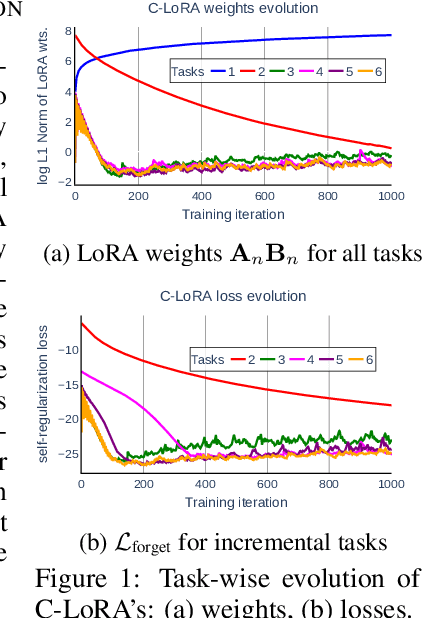
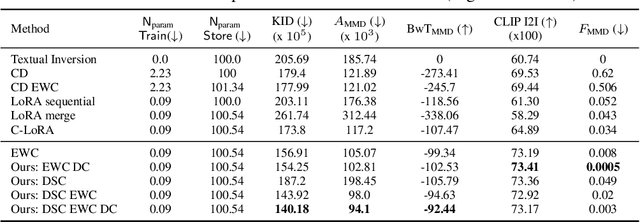
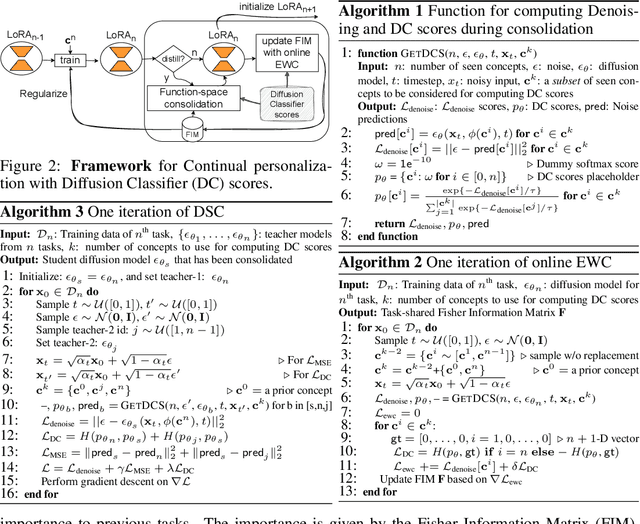
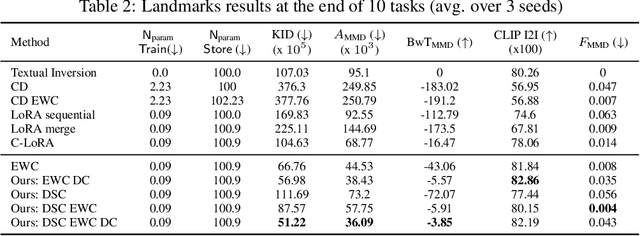
Abstract:Personalized text-to-image diffusion models have grown popular for their ability to efficiently acquire a new concept from user-defined text descriptions and a few images. However, in the real world, a user may wish to personalize a model on multiple concepts but one at a time, with no access to the data from previous concepts due to storage/privacy concerns. When faced with this continual learning (CL) setup, most personalization methods fail to find a balance between acquiring new concepts and retaining previous ones -- a challenge that continual personalization (CP) aims to solve. Inspired by the successful CL methods that rely on class-specific information for regularization, we resort to the inherent class-conditioned density estimates, also known as diffusion classifier (DC) scores, for continual personalization of text-to-image diffusion models. Namely, we propose using DC scores for regularizing the parameter-space and function-space of text-to-image diffusion models, to achieve continual personalization. Using several diverse evaluation setups, datasets, and metrics, we show that our proposed regularization-based CP methods outperform the state-of-the-art C-LoRA, and other baselines. Finally, by operating in the replay-free CL setup and on low-rank adapters, our method incurs zero storage and parameter overhead, respectively, over the state-of-the-art.
A Simple but Strong Baseline for Sounding Video Generation: Effective Adaptation of Audio and Video Diffusion Models for Joint Generation
Sep 26, 2024



Abstract:In this work, we build a simple but strong baseline for sounding video generation. Given base diffusion models for audio and video, we integrate them with additional modules into a single model and train it to make the model jointly generate audio and video. To enhance alignment between audio-video pairs, we introduce two novel mechanisms in our model. The first one is timestep adjustment, which provides different timestep information to each base model. It is designed to align how samples are generated along with timesteps across modalities. The second one is a new design of the additional modules, termed Cross-Modal Conditioning as Positional Encoding (CMC-PE). In CMC-PE, cross-modal information is embedded as if it represents temporal position information, and the embeddings are fed into the model like positional encoding. Compared with the popular cross-attention mechanism, CMC-PE provides a better inductive bias for temporal alignment in the generated data. Experimental results validate the effectiveness of the two newly introduced mechanisms and also demonstrate that our method outperforms existing methods.
Discriminator-Guided Cooperative Diffusion for Joint Audio and Video Generation
May 28, 2024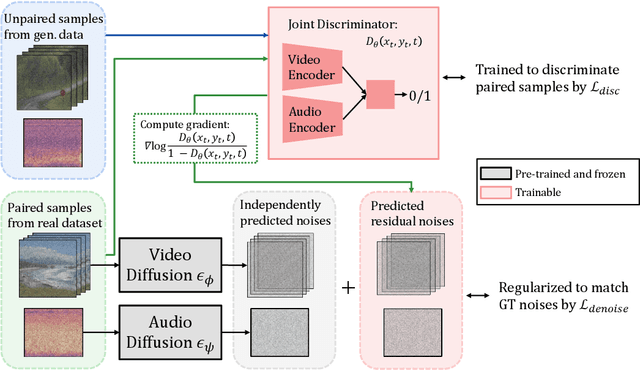
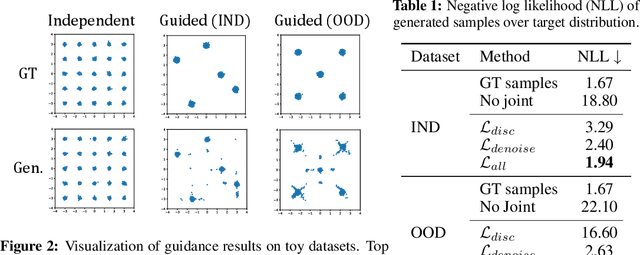

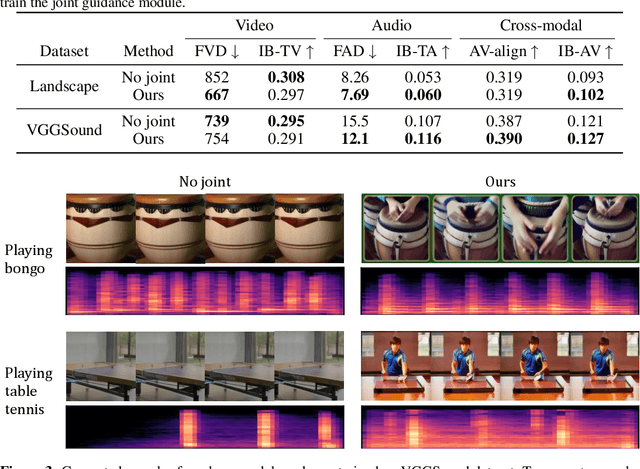
Abstract:In this study, we aim to construct an audio-video generative model with minimal computational cost by leveraging pre-trained single-modal generative models for audio and video. To achieve this, we propose a novel method that guides each single-modal model to cooperatively generate well-aligned samples across modalities. Specifically, given two pre-trained base diffusion models, we train a lightweight joint guidance module to adjust scores separately estimated by the base models to match the score of joint distribution over audio and video. We theoretically show that this guidance can be computed through the gradient of the optimal discriminator distinguishing real audio-video pairs from fake ones independently generated by the base models. On the basis of this analysis, we construct the joint guidance module by training this discriminator. Additionally, we adopt a loss function to make the gradient of the discriminator work as a noise estimator, as in standard diffusion models, stabilizing the gradient of the discriminator. Empirical evaluations on several benchmark datasets demonstrate that our method improves both single-modal fidelity and multi-modal alignment with a relatively small number of parameters.
Visual Echoes: A Simple Unified Transformer for Audio-Visual Generation
May 23, 2024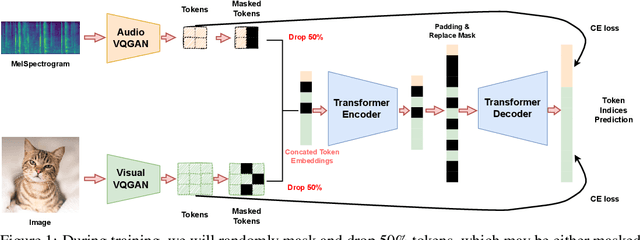

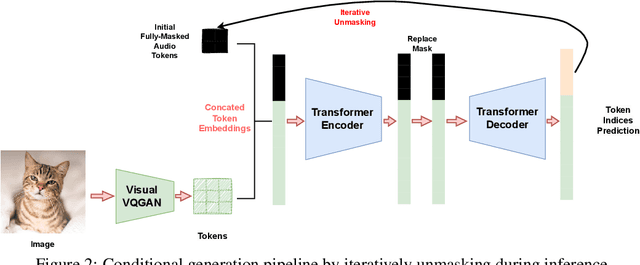
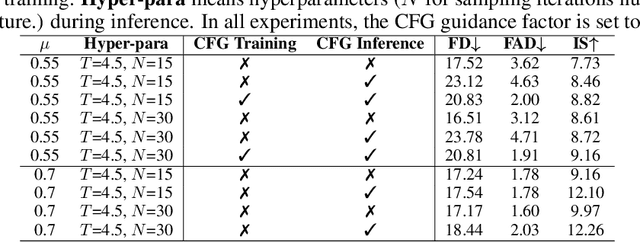
Abstract:In recent years, with the realistic generation results and a wide range of personalized applications, diffusion-based generative models gain huge attention in both visual and audio generation areas. Compared to the considerable advancements of text2image or text2audio generation, research in audio2visual or visual2audio generation has been relatively slow. The recent audio-visual generation methods usually resort to huge large language model or composable diffusion models. Instead of designing another giant model for audio-visual generation, in this paper we take a step back showing a simple and lightweight generative transformer, which is not fully investigated in multi-modal generation, can achieve excellent results on image2audio generation. The transformer operates in the discrete audio and visual Vector-Quantized GAN space, and is trained in the mask denoising manner. After training, the classifier-free guidance could be deployed off-the-shelf achieving better performance, without any extra training or modification. Since the transformer model is modality symmetrical, it could also be directly deployed for audio2image generation and co-generation. In the experiments, we show that our simple method surpasses recent image2audio generation methods. Generated audio samples can be found at https://docs.google.com/presentation/d/1ZtC0SeblKkut4XJcRaDsSTuCRIXB3ypxmSi7HTY3IyQ
Instruct 3D-to-3D: Text Instruction Guided 3D-to-3D conversion
Mar 28, 2023Abstract:We propose a high-quality 3D-to-3D conversion method, Instruct 3D-to-3D. Our method is designed for a novel task, which is to convert a given 3D scene to another scene according to text instructions. Instruct 3D-to-3D applies pretrained Image-to-Image diffusion models for 3D-to-3D conversion. This enables the likelihood maximization of each viewpoint image and high-quality 3D generation. In addition, our proposed method explicitly inputs the source 3D scene as a condition, which enhances 3D consistency and controllability of how much of the source 3D scene structure is reflected. We also propose dynamic scaling, which allows the intensity of the geometry transformation to be adjusted. We performed quantitative and qualitative evaluations and showed that our proposed method achieves higher quality 3D-to-3D conversions than baseline methods.
DetOFA: Efficient Training of Once-for-All Networks for Object Detection by Using Pre-trained Supernet and Path Filter
Mar 23, 2023



Abstract:We address the challenge of training a large supernet for the object detection task, using a relatively small amount of training data. Specifically, we propose an efficient supernet-based neural architecture search (NAS) method that uses transfer learning and search space pruning. First, the supernet is pre-trained on a classification task, for which large datasets are available. Second, the search space defined by the supernet is pruned by removing candidate models that are predicted to perform poorly. To effectively remove the candidates over a wide range of resource constraints, we particularly design a performance predictor, called path filter, which can accurately predict the relative performance of the models that satisfy similar resource constraints. Hence, supernet training is more focused on the best-performing candidates. Our path filter handles prediction for paths with different resource budgets. Compared to once-for-all, our proposed method reduces the computational cost of the optimal network architecture by 30% and 63%, while yielding better accuracy-floating point operations Pareto front (0.85 and 0.45 points of improvement on average precision for Pascal VOC and COCO, respectively).
Fine-grained Image Editing by Pixel-wise Guidance Using Diffusion Models
Dec 08, 2022Abstract:Generative models, particularly GANs, have been utilized for image editing. Although GAN-based methods perform well on generating reasonable contents aligned with the user's intentions, they struggle to strictly preserve the contents outside the editing region. To address this issue, we use diffusion models instead of GANs and propose a novel image-editing method, based on pixel-wise guidance. Specifically, we first train pixel-classifiers with few annotated data and then estimate the semantic segmentation map of a target image. Users then manipulate the map to instruct how the image is to be edited. The diffusion model generates an edited image via guidance by pixel-wise classifiers, such that the resultant image aligns with the manipulated map. As the guidance is conducted pixel-wise, the proposed method can create reasonable contents in the editing region while preserving the contents outside this region. The experimental results validate the advantages of the proposed method both quantitatively and qualitatively.
Semi-supervised learning by selective training with pseudo labels via confidence estimation
Mar 15, 2021



Abstract:We propose a novel semi-supervised learning (SSL) method that adopts selective training with pseudo labels. In our method, we generate hard pseudo-labels and also estimate their confidence, which represents how likely each pseudo-label is to be correct. Then, we explicitly select which pseudo-labeled data should be used to update the model. Specifically, assuming that loss on incorrectly pseudo-labeled data sensitively increase against data augmentation, we select the data corresponding to relatively small loss after applying data augmentation. The confidence is used not only for screening candidates of pseudo-labeled data to be selected but also for automatically deciding how many pseudo-labeled data should be selected within a mini-batch. Since accurate estimation of the confidence is crucial in our method, we also propose a new data augmentation method, called MixConf, that enables us to obtain confidence-calibrated models even when the number of training data is small. Experimental results with several benchmark datasets validate the advantage of our SSL method as well as MixConf.
 Add to Chrome
Add to Chrome Add to Firefox
Add to Firefox Add to Edge
Add to Edge